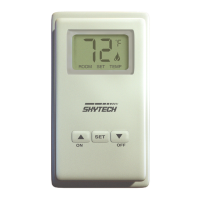• Slide the 3-position button on the remote receiver to the ON position. The main gas flame (i.e., the fire) should ignite.
• Slide the button to OFF. The flame should extinguish (the pilot flame will remain on).
• Slide the button to REMOTE (the center position), then press the ON button on the transmitter to change the system to ON. The
main gas flame should ignite.
• Press the ON button on the wall transmitter to change the system to OFF. The flame should extinguish (the pilot flame will remain
on).
• Press the ON button on the wall transmitter to change the system to THERMO. Advance the SET temperature on the transmitter
to a temperature of a least 2
0
F (1
0
C) above the ROOM temperature displayed on the LCD screen. With this manual setting, the
normal thermostatic cycle is overridden and the system flame will ignite. Set the SET temperature to at least 2
0
F (1
0
C) below the
room temperature and the system flame will extinguish in a few seconds. Thereafter, it should continue to cycle to on and off
thermostatically approximately every two minutes as the ROOM temperature changes, but only when the temperature differential
between ROOM and SET temperatures differ at least 2
0
F (1
0
C). The 2
0
F differential is the factory setting.
ELECTRONIC IGNITION SYSTEMS
• Slide the 3-position button on the remote receiver to the ON position. The spark electrode should begin sparking to ignite the pilot
(the pilot may ignite after only one spark). After the pilot flame is lit, the main gas valve should open and the main gas flame
should ignite.
• Slide the button to OFF. The main gas flame and pilot flame should BOTH extinguish.
• Slide the button to REMOTE (the center position), then press the ON button on the wall transmitter to change the system to ON.
The spark electrode should begin sparking to ignite the pilot. After the pilot is lit, the main gas valve should open and the main gas
flame should ignite.
• Press the ON button on the wall transmitter to OFF. The main gas flame and pilot flame should BOTH extinguish.
• Press the ON button on the wall transmitter to change the system to THERMO. Advance the SET temperature on the transmitter
to a temperature of at least 2
0
F (1
0
C) above the ROOM temperature displayed on the LCD screen. With this manual setting the
normal thermostatic cycle is overridden and the system flame will ignite. Set the SET temperature to at least 2
0
F (1
0
C) below the
room temperature and the system flame will extinguish in a few seconds. Thereafter, it should continue to cycle to on and off
thermostatically approximately every two minutes as the ROOM temperature changes, but only when the temperature differential
between ROOM and SET temperatures differ at least 2
0
F (1
0
C). (The 2
0
F differential is the factory setting).
GENERAL INFORMATION
LEARNING TRANSMITTER TO RECEIVER
Each transmitter uses a unique security code. It will be necessary to press the LEARN button on the receiver to accept the transmitter
security code upon initial use, if batteries are replaced, or if a replacement transmitter is purchased from your dealer or the factory. In
order for the receiver to accept the transmitter security code, be sure the slide button on the receiver is in the REMOTE position; the
receiver will not LEARN if the slide switch is in the ON or OFF position. The LEARN button in located on the front face of the receiver;
inside the small hole labeled LEARN. Using a small screwdriver or end of a paperclip gently press and release the black LEARN button
inside the hole. When you release the LEARN button the receiver will emit an audible “beep”. After the receiver emits the beep press
the transmitter ON button and release. The receiver will emit several beeps indicating that the transmitter’s code has been accepted
into the receiver.
The microprocessor that controls the security code matching procedure is controlled by a timing function. If you are unsuccessful in
matching the security code on the first attempt, wait 1-2 minutes before trying again – this delay allows the microprocessor to reset its
timer circuitry – and try up to two or three more times.
THERMO FUNCTION
When the transmitter is in the THERMO mode, it should be kept away from direct sources of heat such as fireplaces, incandescent
lighting, and direct sunlight. Leaving the transmitter in direct sunlight, for example, will cause its heat-sensing diode to read the room
temperature higher than it actually is; if in THERMO mode, it may not turn on the appliance even if the ambient ROOM temperature is
below the SET temperature.
BATTERY LIFE
Life expectancy of alkaline batteries in the SKYTECH A-TS/R-2A should be at least 12 months. Check and replace all batteries
annually. When the Wall Transmitter no longer operates or the remote receiver does not function at all, the batteries should be
checked. It is important that the remote receiver batteries are fully charged, providing a combined output voltage of at least 5.3 volts.
The length of the wire between the remote receiver and the gas valve directly affects the operating performance of the remote system.
The longer the wire, the more battery power is required to deliver signals between the remote receiver and the gas valve. The Wall
Transmitter should operate with as little as 2.4 volts of battery power, measuring at each of the 3-volt button cell batteries.

